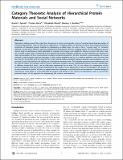Category Theoretic Analysis of Hierarchical Protein Materials and Social Networks
Author(s)
Giesa, Tristan; Wood, Elizabeth; Spivak, David I; Buehler, Markus J
DownloadSpivak-2011-Category Theoretic A.pdf (1.652Mb)
PUBLISHER_CC
Publisher with Creative Commons License
Creative Commons Attribution
Terms of use
Metadata
Show full item recordAbstract
Materials in biology span all the scales from Angstroms to meters and typically consist of complex hierarchical assemblies of simple building blocks. Here we describe an application of category theory to describe structural and resulting functional properties of biological protein materials by developing so-called ologs. An olog is like a “concept web” or “semantic network” except that it follows a rigorous mathematical formulation based on category theory. This key difference ensures that an olog is unambiguous, highly adaptable to evolution and change, and suitable for sharing concepts with other olog. We consider simple cases of beta-helical and amyloid-like protein filaments subjected to axial extension and develop an olog representation of their structural and resulting mechanical properties. We also construct a representation of a social network in which people send text-messages to their nearest neighbors and act as a team to perform a task. We show that the olog for the protein and the olog for the social network feature identical category-theoretic representations, and we proceed to precisely explicate the analogy or isomorphism between them. The examples presented here demonstrate that the intrinsic nature of a complex system, which in particular includes a precise relationship between structure and function at different hierarchical levels, can be effectively represented by an olog. This, in turn, allows for comparative studies between disparate materials or fields of application, and results in novel approaches to derive functionality in the design of de novo hierarchical systems. We discuss opportunities and challenges associated with the description of complex biological materials by using ologs as a powerful tool for analysis and design in the context of materiomics, and we present the potential impact of this approach for engineering, life sciences, and medicine.
Date issued
2011-09Department
Massachusetts Institute of Technology. Center for Materials Science and Engineering; Massachusetts Institute of Technology. Center for Computational Engineering; Massachusetts Institute of Technology. Department of Civil and Environmental Engineering; Massachusetts Institute of Technology. Department of Mathematics; Massachusetts Institute of Technology. Laboratory for Atomistic and Molecular MechanicsJournal
PLoS ONE
Publisher
Public Library of Science
Citation
Spivak, David I. et al. “Category Theoretic Analysis of Hierarchical Protein Materials and Social Networks.” Ed. Laurent Kreplak. PLoS ONE 6.9 (2011): e23911. Web. 15 Feb. 2012.
Version: Final published version
ISSN
1932-6203